It’s been a rocky time for the average employee. After a global pandemic, more people than ever have quit their job or abandoned the office to work from home. The big question is, has all the uncertainty affected how much work people do?
Employee productivity is defined as the efficiency of a worker, or how much they can get done over a period of time. It’s a value assessment placed on workers by their employers and is used as a metric of success by business leaders.
So what is it that influences workers' efficiency?
What are the biggest distractions in the workplace?
How much time do we spend on them?
Do meetings impact workers’ productivity?
How much do we really get done in a day?
We can tell you all that, and more. We’ve gathered the most significant statistics to give you a snapshot of productivity in the workplace.
We’ll show you:
A compilation of the most up-to-date statistics and facts on employee productivity.
The latest and most studied trends in workplace productivity.
A look at the impact of coronavirus on how productive employees are in the office and at home.
General Employee Productivity Statistics
Let’s start with a big number:
... employee disengagement cost the global economy$7.8 trillionin lost productivity in the last year (Gallup,State of the Global Workplace: 2022 Report).
Weshouldaim to be productive for 75% of our working day (Zippia, 2022).
In reality, only2 hours and 48 minutesare spent being highly productive by the average office worker…(RescueTime).
…but at least 79% admit it, saying they don’t think they’re productive throughout their working day (VoucherCloud).
7% of workers feel productive in the office during the work week (Flexjobs).
Productivity rates are higher over the weekend (48%) than they are Monday to Friday (46%) (Hubstaff, Productivity Benchmarks Report).
About 60% of work time is spent productively (Atlassian).
If you want a more productive workplace, you need your employees to be engaged. Why? The experts at Gallup put it best—“The termemployee engagementdescribes a psychological commitment to one’s work… Engaged employees are mentally in the zone, ready for action.”(Gallup, 2022).
Engaged teams show 17% higher productivity in their work (Gallup).
Highly engaged employees are 27% more likely to rate their work performance as excellent (Gallup).
Businesses with higher employee engagement were 18% more productive in sales, and 23% more profitable (Gallup, Employee Engagement and Performance).
But, only 21% of employees claim that they’re engaged (Gallup, 2022).
Employee engagement and productivity go hand in hand, except a lot of us don’t feel that way at work, at least not recently. Maybe that’s because of the disruption of the last few years. Covid-19 caused dramatic changes to everyone’s working life. The big question is, how productive are employees after the switch to working from home?
Check out more key statistics:
Work From Home Productivity Statistics
Over 70% of full-time US employees have been hybrid working since the lockdown (OwlLabs, State of Remote Work, 2021).
The vast majority of workers (83%) don’t think they need to be in an office to be productive (Fuze, WorkForce Futures, 2022).
Employees clock in for an average of three more hours a day, compared to pre-pandemic working patterns (Bloomberg).
55% say they work more hours remotely than working in an office (OwlLabs, 2021).
Remote and freelance employees are productive for 87% of their day (Enterprise Apps, 2022).
So people claim to be working more from home, but how productive are they sitting in their favorite chair?
During the pandemic, 40% of US employees said they were more productive working from home than in the office (National Bureau of Economic Research, Why Working from Home Will Stick, 2021).
Since then, that number has gone up, with 90% of employees now claiming they are as productive or more when working from home (OwlLabs, 2021).
Only 1% say they are less productive(OwlLabs, 2021).
Employers say that home-based workers are 42% more productive and that a remote worker’s efficiency is 38% higher (GitLab, The Remote Work Report, 2021).
Just 5% of workers cited productivity as a major concern with remote work (Hogan Assessments, Future of Work Report, 2021).
New WFH measures can boost productivity by 5% compared to pre-pandemic levels (National Bureau of Economic Research, 2021).
Office workers spend more time unproductively (37 minutes) than remote employees (27 minutes) in an average workday (Airtasker, 2020).
Remote workers take twenty-two minutes a day on breaks, while office-based employees take 18 minutes (Airtasker, 2020).
You read that right. People who work from home take more breaks, but they’re more productive. Cue the sounds of disbelief. It’s true though.
Research proves thatthe top ten percent of most productive employees take more break time(Draugiem Group).
37% of remote employees like to take regular breaks to stay productive (Airtasker).
And the most productive employees work for 52 minutes before they take a break of 17 minutes (DeskTime).
There’s a 56% decrease in unproductive time over the average day when working remotely vs at the office (Time Doctor).
30% of remote employees say they accomplish more work in less time (ConnectSolutions).
Not so long ago, saying you'll work from home was like admitting to playing hooky. Now it’s normal, and people get a lot done from the spare bedroom home office. It helps that advances in technology can let employees stay productive in these unusual times.
Want to work from home? Check out our best side hustle apps.
Technology and Productivity in the Work Place
During the lockdown, over 75% of employees used video-conferencing when working remotely, with 75% reporting increased productivity because of it (Lifesize, Impact of Video Conferencing Report).
Using digital time-management tools increases employee efficiency by 47%... but 82% don’t use any at all (Clockify, 2022).
46% of workers feel more productive thanks to the use of email, the internet, and cell phones (Pew Research).
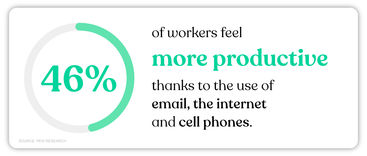
Instant messaging systems have improved things too:
Slack claims that its app improves productivity by 32% (Slack, 2022).
80% of Microsoft Teams users thought the app made them more productive (Forrester, The Total Economic Impact Of Microsoft Teams).
Using technology for collaboration can increase team efficiency by 131% (Kitaboo, 2022).
Using gamification apps make 89% of employees feel more productive, and another 89% say they’d be even more productive with more gamification (TalentLMS, The 2019 Gamification at Work Survey).
Improving productivity is the number one reason for investing in so-calleddesklesstechnology (Emergence, The Rise of the Deskless Workforce).
There’s a load of evidence that new tech can promote employee productivity. There’s also a lot of data to show that it’s not so simple.
Sometimes, tech can be the problem.
When Slack went down, productivity rose by 5% among workers (RescueTime).
Unproductive email management takes up to eleven hours a week (Mailbird, 2021).
2 in 3 employees say outdated technology hurts their productivity (ZenBusiness).
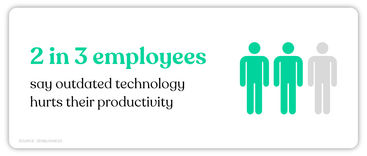
Forty minutes every day are lost to outdated tech at work (ZenBusiness).
64% of employees say they visit nonwork-related websites every day, resulting in a net 40% loss in productivity for business each year (SentryPC).
Clearly, there are some bugs to work out. But that won’t stop businesses from using every piece of new technology they can to increase productivity. We’re already seeing the start of new trends.
81% of employees think using Artificial Intelligence will improve their productivity (SnapLogic, 2021).
Already, 61% of workers use AI to be more productive (SnapLogic, 2021).
Using AI in call centers has improved employee productivity by 30% (New York Times, Why Isn’t New Technology Making Us More Productive? 2022).
71% of workers believe wearable tech (like smartwatches) has increased their efficiency (HubSpot, 2021).
Employees with wearable technology have proven to be 8.5% more productive (Rackspace, The Human Cloud at Work).
There’s a lot that technology can do to improve employee productivity, but only if it’s used right. Spend all your time playing solitaire, and no smartwatch on earth can make you more productive at work. That brings us to the ways people waste their time at work. The productivity killers.
How Productive Are You at Work?
What are the biggest drains on the productivity of employees?
Distractions take up about 28% of each day at work (Hubspot, 2022).
Among the top distractions people report at work are:
Checking social media (44 minutes a day)
News Websites (65 minutes)
Socializing with colleagues (40 minutes)
Making snacks (15 minutes)
Smoking breaks (23 minutes)
Job hunting (26 minutes) (VoucherCloud)
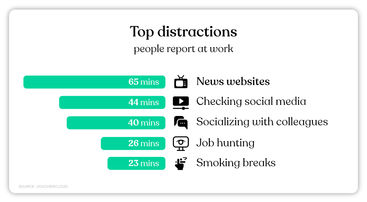
Admit it. You’re guilty of at least two of those. Looking at that list, it looks like the internet is the number one culprit for killing productivity.
Employees spend five hours every week surfing the web(HubSpot, 2021).
About 39% of employees think the internet prohibits their productivity (HubSpot, 2021).
But, it’s not just the internet that stops employees from working. Sometimes the work itself gets in the way.
Up to 60% of workers think unnecessary meetings affect their productivity (Udemy, Workplace Distraction Report).
Thirty-one hours of unproductive meeting time takes place over a month (Atlassian).
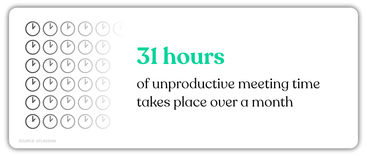
65% of employees say that attending meetings stops them from completing their work (Zippia, 2022).
Multitasking causes workers to lose up to 40% of their productivity (Harvard Business Review).
And businesses become 28% less productive when employees ineffectively multitask (Realization, 2022).
Even the office itself (or that spare room) can be a distraction.
Over half of employees (53%) are less productive when the office is too cold.
Nearly three-quarters (71%) aren’t efficient if it’s too warm (CareerBuilder).
80% of office employees say loud co-workers distract them from work, with 70% saying general office noise does the same (Udemy).
I get it. Those printers can beloud. The problem with all these distractions is that employees rarely get all their work done. That leads to stress, which leads to less productivity, leading to more stress, and even less productivity…
Health, Happiness, and Productivity at Work Statistics
An unsurprising 63% of employees link declining health to loss of workplace productivity (The Hartford, Future of Benefits Pulse Survey, 2022).
56% of workers say stress negatively affects their work performance (ADAA).
A fifth of all employees spends five hours a week thinking about their worries and getting stressed, with 41% saying this leads to a loss of productivity (Colonial Life).
Stress-related illnesses cause $200–$300 billion in lost productivity every year (Health Advocate, Stress in the Workplace).
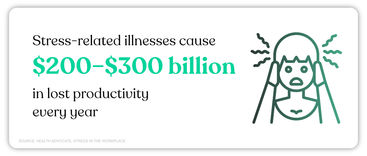
50%–70% of European businesses report a loss of productivity because of employee health (BMC Public Health).
Employee burnout has remained high since the pandemic, with 61% of workers reporting their work is suffering because of ill health (The Hartford, 2022).
Depression in the workplace costs the US between $37 billion and $52 billion every year (American Journal of Health Promotion).
The American Psychiatric Association estimates depressed employees are 35% less productive (McLean-Harvard Medical School, 2022).
Unhealthy diets cause a 66% drop in productivity, with simple changes making a big difference in work life (Population Health Management).
That’s the bad news. The good news is that there are simple ways employees can stay healthy and productive at the same time.
Daily exercise improves time management and workload completion by 72% (International Journal of Workplace Health Management, 2008).
71% of workers are more productive and relaxed with music on(Robert Half).
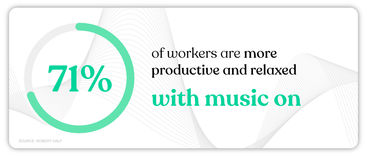
Proper nutrition increases employee productivity by 25% (Oak Engage, 2022).
A 3–4% drop in hydration can make a worker’s productivity drop by 25%, so drink plenty during the day (Clockify, 2022).
Light exercise at work can boost employee productivity by 72% (JOEM).
More sleep can improve employee concentration and performance-saving companies almost $2,000 a year in lost productivity per employee (JOEM).
Workers are 13% more productive when they’re happy and healthy (University of Oxford/Saïd Business School).
Employees with a good work-life balance work 21% harder (Corporate Executive Board).
Happier employees take ten times fewer sick days than unhappy employees and are more productive (Lorman, 2021).
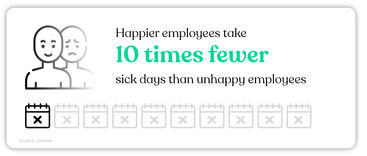
If you’re stressed, miserable, and tired, you’re going to be a less productive employee. That’s kind of obvious. What if you’ve felt tired for decades? Or if you’re feeling the stress that comes with that firstproper job? How does the generation gap affect productivity?
Workforce Productivity Statistics
73% of Baby Boomers and 72% of Gen X are not engaged or actively disengaged, at work—compared to 67% of Millennials (Gallup).
70% of Gen Z would switch jobs for access to better tech to help productivity, but only 52% of Gen X and 37% of Boomers agree (Adobe, Future of Time, 2022).
Over a third of Millennials and Gen X use their tech at work for personal reasons—adding up to almost ten hours a week spent unproductively (Udemy).
Gen Z is the most convinced tech is essential for productivity, at 57% (Monster).
26% of Gen Z are the most productive working late hours (6pm–3am), compared to 6% of Baby Boomers (Adobe, 2022).
So younger people use their phones at work more and stay up later. You probably expected that. But did you expect this…
Only 19% of Gen X and Baby Boomers feel more productive in the office than at home.
Gen Z likes being in the office a lot more, with 32% saying that’s where they get the most done (Hubble, 2022).
Almost a third of the entire workforce (and 50% of Gen Z) plans on switching careers in the next year because of time and productivity pressures (Adobe, 2022).
The average working week in the US is around 35 hours, but 73% of Millennials work over 40 hours a week (TeamStage, 2022).

90% of all workers think that conflict between generations results in lost productivity (Forbes).
70% of employers think that Gen X is the hardest and most productive worker overall (Undercover Recruiter, 2022).
But it’s Millennials that value productivity more, with 90% believing that it’s the key to happiness (Due/Microsoft, 2021).
Everyone has their own opinion on which generation is the hardest working. And it’s usually their own. What really matters is how we can improve our productivity, while having a work-life balance.
Ways to Improve Employee Productivity
In what ways can business leaders increase employee productivity? It starts with listening to their worker’s ideas.
One in three workers say that social networking can enhance productivity—40% of Boomers, 46% of Gen Z, and 50% of Millennials agree that this is a good way to improve efficiency (Queen’s University University of Charlotte, 2021).
Gamified training makes 83% of employees more motivated and productive, and 78% say it would help in the recruiting process too (Talent LMS).
Up to 70% of workers think more training would help avoid distractions (Udemy).
Switching to remote work made 91% of people believe they could get more done (Tiny Pulse).
Giving employees the option of flexible and hybrid working decreases burnout by 22%—and they even work 1.4 more days every month compared to in-office colleagues (Airtasker).
In offices, 86% of workers are more productive when they can work alone (HubSpot, 2022).
76% of people think improving workplace culture will improve employee productivity (Eagle Hill Consulting, The Business Case for Culture).
Changing the office is always going to be a gamble, but if you want a more motivated workforce, roll the dice. If it’s too much of a risk, there are other ways to increase employee productivity.
40% of Americans are more productive when rewarded in ways other than just their paycheck (Fonder).
Even simple job recognition makes 37% of employees more productive (TonerBuzz, 2022).
22% of workers leave the office to get hot drinks, with a net loss of $15,000 a year for an office of fifty people (HubSpot).
Over 90% of employers believe access to health benefits makes employees more productive (SHRM).
66% of employees report they feel more productive when they get more sleep (Glassdoor).
Building employee engagement can reduce absenteeism by 41%, and boost productivity by 14% (Gallup, 2022).
Key Takeaway
Let’s wrap this up. There are alotof statistics on employment productivity out there, but if employers really want to improve workers’ efficiency, there’s really one golden rule.
Look after your employees, and they’ll look after your bottom line.
It might not be as simple as that all the time, but it sure is a good place to start. If you want your workforce to be more productive, and more engaged, then ask them what they think would help. I’m pretty sure they’ll have some good ideas.




